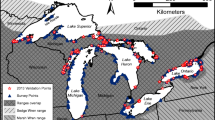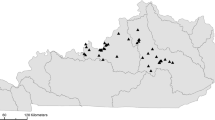Abstract
Small, seasonal pools and temporary ponds (<4.0 ha) are the most numerous and biologically diverse wetlands in many natural landscapes. Thus, accurate determination of their numbers and spatial characteristics is beneficial for conservation and management of biodiversity associated with these freshwater systems. We examined the utility of a topographic position index (TPI) landscape classification to identify and classify depressional wetlands. We also assessed relationships between topographic characteristics and ponded duration of known wetlands to allow hydrological characteristics to be extended to non-monitored locations in similar landscapes. Our results indicate that this approach was successful at identifying wetlands, but did have higher errors of commission (10%) than omission (5%). Additionally, the TPI procedure provided a reasonable means to correlate general ponded duration characteristics (long/short) with wetland topography. Although results varied by hydrologic class, permanent/long ponded duration wetlands were more often classified correctly (80%) than were short ponded duration wetlands (67%). However, classification results were improved to 100 and 75% for permanent/long and short ponded duration wetlands, respectively, by removing wetlands occurring on an abrupt marine terrace that erroneously inflated pond topographic characteristics. Our study presents an approach for evaluating wetland suitability for species or guilds that are associated with key habitat characteristics, such as hydroperiod.






Similar content being viewed by others
References
Anderson TL, Heemeyer JL, Peterman WE, Everson MJ, Ousterhout BH (2015) Automated analysis of temperature variance to determine inundation status of wetlands. Wetlands Ecology and Management 1–9. doi:10.1007/s11273-015-9439-x
Babbitt KJ, Baber MJ, Tarr TL (2003) Patterns of larval amphibian distribution along the wetland hydroperiod gradient. Canadian Journal of Zoology 81:1539–1552
Barker R, King DJ (2012) Blanding’s turtle (emydoidea blandingii) potential habitat mapping using aerial orthophotographic imagery and object based classification. Remote Sensing 4:194–219
Brooks RT (2000) Annual and seasonal variation and the effects of hydroperiod on benthic macroinvertebrates of seasonal forest (“vernal”) wetlands in central Massachusetts, USA. Wetlands 20:707–715
Brooks RT (2004) Weather-related effects on woodland vernal pool hydrology and hydroperiod. Wetlands 24:104–114
Brooks RT, Hayashi M (2002) Depth-area-volume and hydroperiod relationships of ephemeral (“vernal”) forest pools in southern New England. Wetlands 22:247–255
Comer P, Goodin K, Tomaino A, Hammerson G, Kittel G, Menard S, Nordman C, Pyne M, Reid M, Sneddon L, Snow K (2005) Biodiversity values of geographically isolated wetlands in the United States. NatureServe, Arlington
Cowardin LM, Carter V, Golet FC, LaRoe ET (1979) Classification of Wetlands and deepwater habitats of the United States. U.S. Department of the Interior, Fish and Wildlife Service, Washington, DC
Dahl TE, Dick J, Swords J, Wilen BO (2015) Data collection requirements and procedures for mapping wetland, deepwater and related habitats of the United States. Division of Habitat and Resource Conservation (version 2), National Standards and Support Team, Madison, 92 p
De Reu J, Bourgeois J, Bats M, Zwertvaegher A, Gelorini V, De Smedt P, Chu W, Antrop M, De Maeyer P, Finke P, Van Meirvenne M (2013) Application of the topographic position index to heterogeneous landscapes. Geomorphology 186:39–49
Dewberry (2009) Final report of specific purpose lidar survey – Lidar, breaklines, and contours for Wakulla County, Florida. Prepared for the State of Florida Division of Emergency Management. http://nwfwmdlidar.com/Metadata/LAS/FDEM/Survey_Report_for_Wakulla_County_FL.pdf
Doctor DA, Young JA (2013) An evaluation of automated GIS tools for delineating karst sinkholes and closed depressions from 1-meter LIDAR-derived digital elevation data. Proceedings of the thirteenth multidisciplinary conference on sinkholes and the engineering and environmental impacts on karst. Carlsbad, New Mexico: National Cave and Karst Research Institute, p. 449–458
Fahrig L (2003) Effects of habitat fragmentation on biodiversity. Annual Review of Ecology, Evolution, and Systematics 34:487–515
Gao X, Alvo M, Chen J, Li G (2008) Nonparametric multiple comparison procedures for unbalanced one-way factorial designs. Journal of Statistical Planning and Inference 138(8):2574–2591
Garmendia A, Pedrola-Monfort J (2010) Simulation model comparing the hydroperiod of temporary ponds with different shapes. Limnetica 29:145–152
Gibbs JP (1993) Importance of small wetlands for the persistence of local populations of wetland-associated animals. Wetlands 13:25–31
Gómez-Rodríguez C, Bustamante J, Díaz-Paniagua C (2010) Evidence of hydroperiod shortening in a preserved system of temporary ponds. Remote Sensing 2:1439–1462
Haag KH, Lee TM, Herndon DC (2005) Bathymetry and vegetation in isolated marsh and cypress wetlands in the northern Tampa Bay area, 2000–2004: U.S. Geological Survey Scientific Investigations Report 2005–5109, p 49
Huang C, Peng Y, Lang M, Yeo IY, McCarty G (2014) Wetland inundation mapping and change monitoring using Landsat and airborne LiDAR data. Remote Sensing of Environment 141:231–242
Jenness J, Brost B, Beier P (2011) Land facet corridor designer: extension for ArcGIS. Jenness enterprises. Available from: http://www.jennessent.com/arcgis/land_facets.htm. Accessed 12 Mar 2013
Johnson SA (2002) Life history of the striped newt at a north-central Florida breeding pond. Southeastern Naturalist 1:381–402
Johnson SA (2005) Conservation and life history of the striped newt, the importance of habitat connectivity. In: Meshaka WE, Babbit KJ (eds) Amphibians and reptiles: status and conservation in Florida. Krieger, Malabar, pp 91–98
Konietschke F, Placzek M, Schaarschmidt S, Hothorn LA (2014) nparcomp: an R Software Package for nonparametric multiple comparisons and simultaneous confidence intervals. Journal of Statistical Software 61(10):1–17
Lang MW, McCarty GW (2009) Lidar intensity for improved detection of inundation below the forest canopy. Wetlands 29:1166–1178
Lang M, McDonough O, McCarty G, Oesterling R, Wilen B (2012) Enhanced detection of wetland-stream connectivity using LiDAR. Wetlands 32(3):461–473
Lang MW, McCarty GW, Oesterling R, Yeo IY (2013) Topographic metrics for improved mapping of forested wetlands. Wetlands 33:141–155
Leonard PB, Baldwin RF, Homyack JA, Wigley TB (2012) Remote detection of small wetlands in the Atlantic Coastal Plain of North America: local relief models, ground validation, and high-throughput computing. Forest Ecology and Management 284:107–115
Lindsay JB, Cockburn JMH, Russell HAJ (2015) An integral image approach to performing multi-scale topographic position analysis. Geomorphology 245:51–61
MacKenzie D, Nichols JD, Royle JA, Pollock KH, Bailey LA, Hines JE (2006) Occupancy estimation and modeling: inferring patterns and dynamics of species occurrence. Elsevier Academic Press, Burlington
Martin G, Kirkman LK, Hepinstall-Cymerman J (2012) Mapping geographically isolated wetlands in the Dougherty Plain, Georgia, USA. Wetlands 32:149–160
Maxa M, Bolstad P (2009) Mapping northern wetlands with high resolution satellite images and LiDAR. Wetlands 29(1):248–260
McCauley LA, Jenkins DG (2005) GIS-based estimates of former and current depressional wetlands in an agricultural landscape. Ecological Applications 15:1199–1208
McFeeters SK (1996) The use of the normalized difference water index (NDWI) in the delineation of open water features. International Journal of Remote Sensing 17:1425–1432
Mitsch WJ, Gosselink JG (2007) Wetlands, 4th edn. John Wiley & Sons, Hoboken
Murray-Hudson M, Wolski P, Cassidy L, Brown MT, Thito K, Kashe K, Mosimanyana E (2015) Remote sensing-derived hydroperiod as a predictor of floodplain vegetation composition. Wetlands Ecology and Management 23:603–616
National Assessment Synthesis Team (2000) Climate change impacts on the United States: the potential consequences of climate variability and change. U.S. Global Change Research Program, Washington
Ordoyne C, Friedl MA (2008) Using MODIS data to characterize seasonal inundation patterns in the Florida Everglades. Remote Sensing of Environment 112:4107–4119
R Core Team (2012) R: a language and environment for statistical computing. R Foundation for Statistical Computing, Vienna, Austria. ISBN 3-900051-07-0, URL http://www.R-project.org/
Reif M, Frohn RC, Lane CR, Autrey B (2009) Mapping isolated wetlands in a Karst Landscape: GIS and remote sensing methods. GIScience & Remote Sensing 46(2):187–211
Rupert F, Spencer S (1988) Geology of Wakulla County Florida. Florida Geological Survey, Bulletin 60. Tallahassee
Semlitsch RD (2000) Principles of management for aquatic breeding amphibians. Journal of Wildlife Management 64:615–631
Semlitsch RD, Anderson TL, Drake DL, Ousterhout BH, Peterman WE, Shulse CD (2013) Small, clustered wetlands promote amphibian persistence. The National Wetlands Newsletter 35:20–21, Environmental Law Institute, Washington, D.C
Semlitsch RD, Peterman WE, Anderson TL, Drake DL, Ousterhout BH (2015) Intermediate pond sizes contain the highest density, richness, and diversity of pond-breeding amphibians. PLoS ONE 10(4):e0123055. doi:10.1371/journal.pone.0123055
Skidds DE, Golet FC (2005) Estimating hydroperiod suitability for breeding amphibians in southern Rhode Island seasonal woodland ponds. Wetlands Ecology and Management 13:349–366
Snyder D, Lang M (2012) Significance of the 3D Elevation Program to wetlands mapping. National Wetlands Newsletter 34(5):11–15
Tiner RW (1997) NWI maps: what they tell us. National Wetlands Newsletter 19(2):7–12
Tiner RW (2003) Geographically isolated wetlands of the United States. Wetlands 23(3):494–516
U. S. Fish and Wildlife Service (2011) Endangered and threatened wildlife and plants; 12-month finding on a petition to list the striped newt as threatened. Federal Register 76:32911–32929
U. S. Fish and Wildlife Service (2015) FL_Wetlands_Project_Metadata. National wetlands inventory website. U.S. Department of the Interior, Fish and Wildlife Service, Washington, D.C., http://www.fws.gov/wetlands/
Van Meter R, Bailey LL, Grant EHC (2008) Methods for estimating the amount of vernal pool habitat in the Northeastern United States. Wetlands 28:585–593
Walls SC, Barichivich WJ, Brown ME, Scott DE, Hossack BR (2013) Influence of drought on salamander occupancy of isolated wetlands on the southeastern Coastal Plain of the United States. Wetlands 33:345–354
Weishampel JF, Hightower JN, Chase AF, Chase DZ, Patrick RA (2011) Detection and morphologic analysis of potential below-canopy cave openings in the karst landscape around the Maya polity of Caracol using airborne LIDAR. Journal of Cave and Karst Studies 73:187–196
Wilcove DS, Rothstein D, Dubow J, Phillips A, Losos E (1998) Quantifying threats to imperiled species in the United States. Bioscience 48:607–615
Wu Q, Lane C, Liu H (2014) An effective method for detecting potential woodland vernal pools using high-resolution LiDAR data and aerial imagery. Remote Sensing 6(11):11444–11467. doi:10.3390/rs61111444
Acknowledgements
This work was supported by the U.S. Geological Survey’s Amphibian Research and Monitoring Initiative (USGS ARMI) and the USGS/U.S. Fish and Wildlife Service Science Support Partnership (SSP). Thanks to John W. Jones (USGS), the associate editor of Wetlands, and anonymous reviewers for helpful comments that improved this manuscript. The use of trade, firm, or product names does not imply endorsement by the U.S. Government. This is contribution 566 of USGS ARMI.
Author information
Authors and Affiliations
Corresponding author
Rights and permissions
About this article
Cite this article
Riley, J.W., Calhoun, D.L., Barichivich, W.J. et al. Identifying Small Depressional Wetlands and Using a Topographic Position Index to Infer Hydroperiod Regimes for Pond-Breeding Amphibians. Wetlands 37, 325–338 (2017). https://doi.org/10.1007/s13157-016-0872-2
Received:
Accepted:
Published:
Issue Date:
DOI: https://doi.org/10.1007/s13157-016-0872-2




